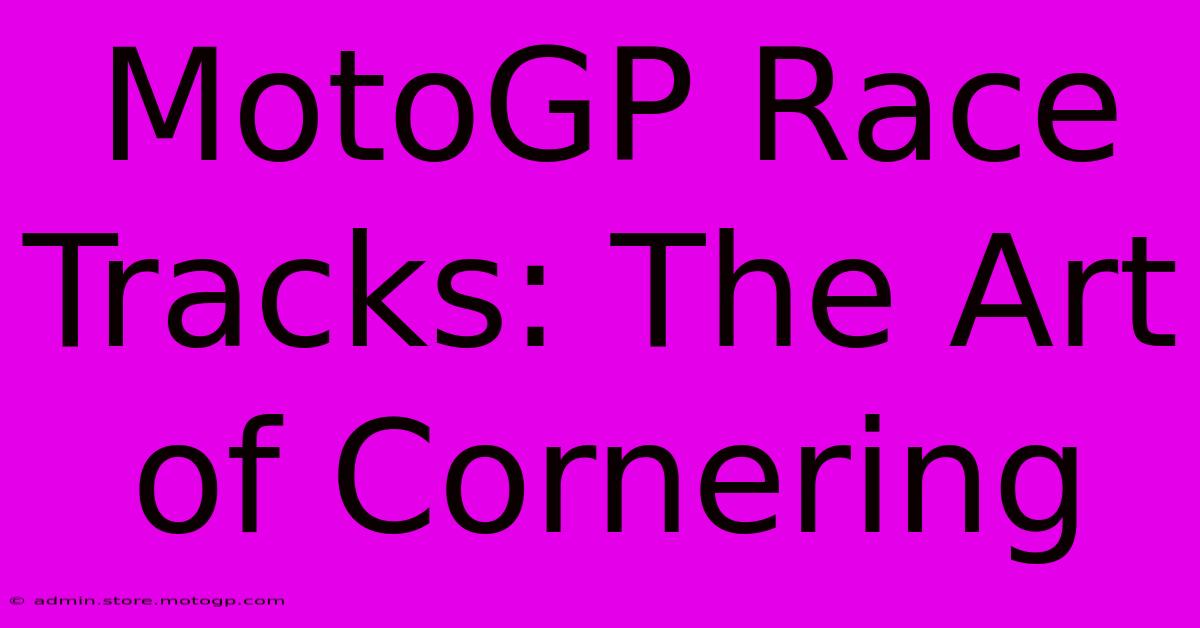MotoGP Race Tracks: The Art Of Cornering

Table of Contents
MotoGP Race Tracks: The Art of Cornering
MotoGP, the pinnacle of motorcycle racing, isn't just about raw horsepower. It's a ballet of precision, skill, and unwavering courage, played out on some of the most challenging race tracks in the world. While speed is crucial, mastering the art of cornering is what truly separates the champions from the contenders. This article delves into the intricacies of MotoGP cornering, exploring the techniques, challenges, and the science behind navigating these breathtaking circuits.
The Physics of Cornering: More Than Just Leaning
Successful cornering in MotoGP is a complex interplay of physics and rider skill. It's not simply about leaning the bike; it's about managing several critical factors:
- Centripetal Force: This is the force that pulls the bike towards the center of the turn. The faster the bike, the greater the centripetal force, requiring a greater lean angle to counteract it.
- Friction: The grip between the tires and the track surface is paramount. This friction provides the necessary force to prevent the bike from sliding out. Tire choice and track conditions heavily influence friction.
- Lean Angle: The degree to which the bike is tilted into the turn. Finding the optimal lean angle is crucial—too little, and the bike runs wide; too much, and it risks a high-side or low-side crash.
- Throttle Control: Subtle throttle adjustments throughout the corner are essential for maintaining stability and optimal trajectory. Rolling off the throttle too abruptly can unsettle the bike.
- Body Positioning: The rider's body position plays a crucial role in weight distribution and bike stability. Leaning with the bike and shifting their weight helps maintain balance.
Understanding Different Types of Corners
MotoGP tracks boast a diverse range of corners, each requiring a unique approach:
- Fast Corners: These require precision, smooth inputs, and maintaining high speed throughout the turn. Riders often rely on trail braking and precise throttle control to navigate these challenging sections.
- Slow Corners: These allow for more precise line selection and potentially more aggressive braking. Riders will often use the entire track width to optimize their trajectory.
- Blind Corners: Entering a corner without a clear view requires exceptional spatial awareness and anticipation. Riders must rely on experience and track knowledge to select the correct line.
- Hairpin Corners: Extremely tight corners requiring significant braking and a near-stop before negotiating the turn. These are often challenging entry and exit points.
The Role of Track Design in Cornering Challenges
The design of a MotoGP race track dictates the challenges faced by riders. Key factors include:
- Corner Radius: The curvature of the corner directly impacts the lean angle and speed required. Tighter corners necessitate a greater lean angle and slower speed.
- Camber: The banking of a corner helps counteract centripetal force, allowing riders to maintain higher speeds.
- Track Surface: The grip level of the asphalt significantly influences tire performance and ultimately, cornering stability. Variations in surface grip add another layer of complexity.
- Elevation Changes: Changes in elevation, such as inclines and declines, significantly impact cornering dynamics, adding an extra dimension of control required.
Beyond the Physics: The Rider's Skill
Mastering the art of cornering in MotoGP transcends the scientific principles. It's a combination of:
- Experience: Years of practice and racing experience are essential for developing the intuition and feel required for precise cornering.
- Bike Setup: The motorcycle's setup, particularly the suspension and geometry, must be tailored to the specific track and conditions.
- Mental Fortitude: Maintaining focus and composure under immense pressure is crucial for consistent performance.
- Reaction Time: Quick reaction times are essential to correct errors and adapt to unexpected events.
Conclusion:
Cornering in MotoGP is a captivating blend of science, skill, and daring. Understanding the physics involved, recognizing the nuances of different corner types, and mastering the bike's handling are all key components to success. The breathtaking speeds and razor-sharp precision displayed by these world-class riders are a testament to the mastery of this intricate art. The next time you watch a MotoGP race, take a moment to appreciate the complex dance of man and machine as they navigate these challenging circuits. It's a spectacle of athleticism and technical brilliance.

Thank you for visiting our website wich cover about MotoGP Race Tracks: The Art Of Cornering. We hope the information provided has been useful to you. Feel free to contact us if you have any questions or need further assistance. See you next time and dont miss to bookmark.
Featured Posts
-
Experience Moto Gp Thrills Motorcycle Seeking New Rider
Feb 18, 2025
-
Cota Transportation The Complete Guide
Feb 18, 2025
-
Formula 1 Parking On A Budget
Feb 18, 2025
-
Yamaha V4 A Thrilling Ride Awaits
Feb 18, 2025
-
The Ultimate Guide To American Moto Gp Riders
Feb 18, 2025
